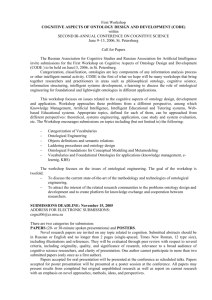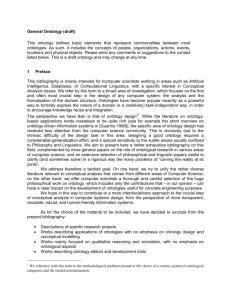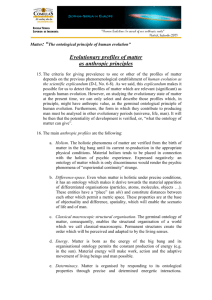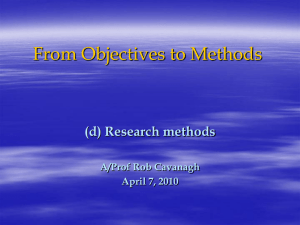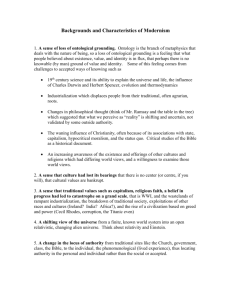Introducing Ontological Realism for Semi-Supervised Detection and Annotation of Operationally Significant
advertisement
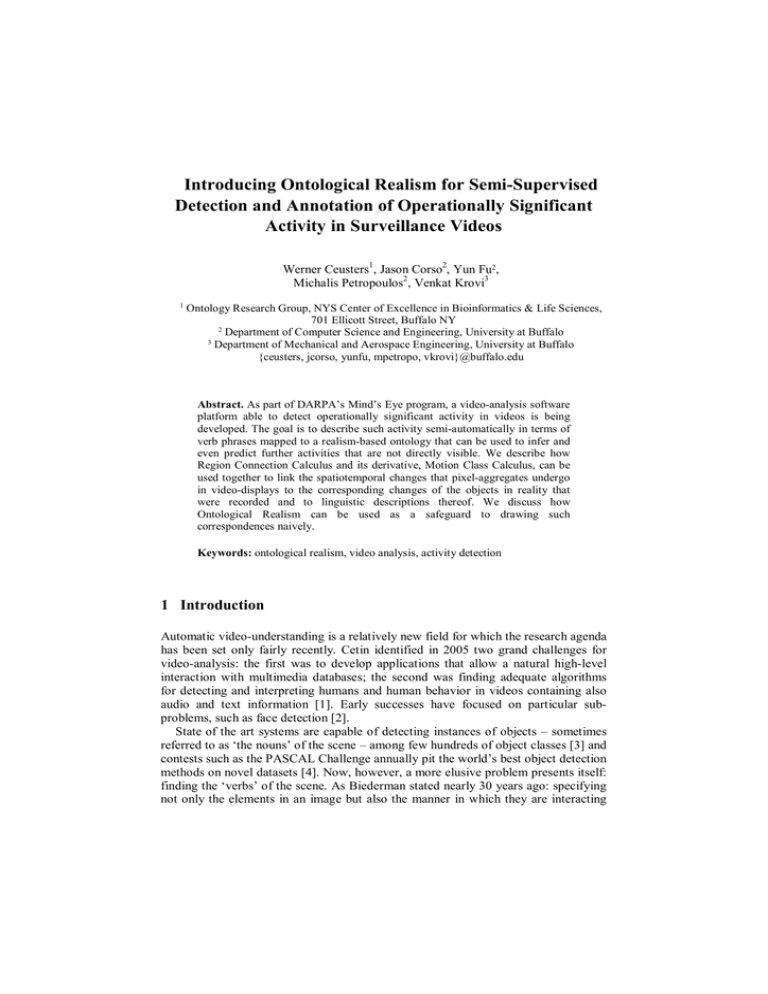
Introducing Ontological Realism for Semi-Supervised
Detection and Annotation of Operationally Significant
Activity in Surveillance Videos
Werner Ceusters1, Jason Corso2, Yun Fu2,
Michalis Petropoulos2, Venkat Krovi3
1
Ontology Research Group, NYS Center of Excellence in Bioinformatics & Life Sciences,
701 Ellicott Street, Buffalo NY
2
Department of Computer Science and Engineering, University at Buffalo
3
Department of Mechanical and Aerospace Engineering, University at Buffalo
{ceusters, jcorso, yunfu, mpetropo, vkrovi}@buffalo.edu
Abstract. As part of DARPA’s Mind’s Eye program, a video-analysis software
platform able to detect operationally significant activity in videos is being
developed. The goal is to describe such activity semi-automatically in terms of
verb phrases mapped to a realism-based ontology that can be used to infer and
even predict further activities that are not directly visible. We describe how
Region Connection Calculus and its derivative, Motion Class Calculus, can be
used together to link the spatiotemporal changes that pixel-aggregates undergo
in video-displays to the corresponding changes of the objects in reality that
were recorded and to linguistic descriptions thereof. We discuss how
Ontological Realism can be used as a safeguard to drawing such
correspondences naively.
Keywords: ontological realism, video analysis, activity detection
1 Introduction
Automatic video-understanding is a relatively new field for which the research agenda
has been set only fairly recently. Cetin identified in 2005 two grand challenges for
video-analysis: the first was to develop applications that allow a natural high-level
interaction with multimedia databases; the second was finding adequate algorithms
for detecting and interpreting humans and human behavior in videos containing also
audio and text information [1]. Early successes have focused on particular subproblems, such as face detection [2].
State of the art systems are capable of detecting instances of objects – sometimes
referred to as ‘the nouns’ of the scene – among few hundreds of object classes [3] and
contests such as the PASCAL Challenge annually pit the world’s best object detection
methods on novel datasets [4]. Now, however, a more elusive problem presents itself:
finding the ‘verbs’ of the scene. As Biederman stated nearly 30 years ago: specifying
not only the elements in an image but also the manner in which they are interacting
and relating to one another is integral to full image understanding [5]. However,
recognizing human actions, especially with a view to understanding their underlying
motivation, has proved to be an extremely challenging task. This is because (1)
behavior is the result of a complex combination of coordinated actions, (2) motion
and behavior are described linguistically at a wide variety of spatiotemporal scales,
and most importantly (3) the unambiguous extraction of intent from motion alone can
never be achieved due to the significant dependence upon contextual knowledge.
Solving these problems, specifically in the context of surveillance, is the objective
of DARPA’s Mind’s Eye program which seeks to embed in a smart camera sufficient
visual intelligence to detect, interpolate and even predict activities in an area of
observation and, as a specific requirement, to describe these activities in terms of
‘verbs’ (Table 1) [6].
As successful proposers to this program, our answer is ISTARE: a platform which
will suitably represent articulated motion in a three-layer hierarchical dynamical
graphical model consisting of (1) a lowest level of representation formed by points,
lines and regions in their spatiotemporal context, (2) a mid-level capturing the spatiotemporal coherence inherent in the appearance, structure and motions of the atoms in
the lower level, and (3) generalizations of the reusable mid-level parts into full objects
and activities at the high-level (Fig.1). Part of that platform is an ontology which
grounds the models with proper semantics thereby driving both learning and
inference. A human-in-the-loop is the bridge between models and symbolic
representations in case of ambiguities. But rather than requiring laborious annotation
in such case, the human simply needs to answer yes/no questions generated by our
methods.
In this communication, we describe our strategy to make the ISTARE approach in
general, and the computational structures resulting from automated video analysis and
annotation within the ISTARE platform specifically, compatible with ongoing
research in the field. Using Motion Classes (MC) as an example, we demonstrate how
Ontological Realism is an important building block in this endeavor and how it is able
to tie the various pieces – reality, spatiotemporal models and linguistic descriptions –
together.
Table 1. Verbs of interest for activity detection in the Mind’s Eye video-analysis program
approach
arrive
attach
bounce
bury
carry
catch
chase
close
collide
dig
drop
enter
exchange
exit
fall
flee
fly
follow
get
give
go
hand
haul
have
hit
hold
kick
jump
leave
lift
move
open
pass
pick up
push
put down
raise
receive
replace
run
snatch
stop
take
throw
touch
turn
walk
Fig. 1: Interaction of spatio-temporal models at three levels of granularity
within the ISTARE platform.
2 Motion Classes
Several formalisms have been introduced to represent and reason with actions. The
basic elements of situation calculus [7-8] are: (1) actions that can be performed in the
world, (2) fluents that describe the state of the world, each fluent thus being the
representation of some property, and (3) situations, a situation being ‘a complete state
of the universe at an instant of time’ [9], a position which is also maintained in fluent
calculus [10]. Event calculus does without situations, and uses only actions and
fluents, whereby the latter are functions – rather than predicates as is the case in
situation calculus – which can be used in predicates such as HoldsAt to state at what
time which fluents hold [11]. These approaches, unfortunately, don’t take ontological
commitment very serious or are based on representational artifacts which do not
follow the principles of ontological realism [12].
The Motion Classes (MC) paradigm [13] which builds further on Region
Connection Calculus (RCC) [14] to describe motions do not suffer from this. RCC
describes how two regions are spatially located in relation to each other, thereby
recognizing eight relations (Fig.2). Five of them are ontologically distinct:
disconnected (DC), externally connected (EC), partially overlapping (PO), tangential
proper part (TPP) and non-tangential proper part (NTPP). Three others are there for
notational purposes: equality (EQ – if we write ‘EQ(x,y)’, then there is in fact only
one region denoted by two distinct symbols ‘x’ and ‘y’), and TPPI and NTPPI as the
inverses of TPP and NTPP.
The Motion Classes paradigm exploits what is called the ‘conceptual
neighborhood’ of the RCC-relations which for each relation is defined as the set of
possible relations that may hold at some point in time when another relation held
earlier (Fig.2). A motion class is the set of transitions from one RCC configuration to
another one that can be achieved by the same basic sort of motion (Fig.3). As an
example, any transition from PO, TPP NTPP, EQ, TPPI and NTPPI to DC, EC or PO
can be achieved through a LEAVE motion, i.e. a motion which separates the two
regions from each other. Although there are 64 (82) distinct types of transitions which
thus theoretically could be caused by 64 distinct types of motions, closer inspection
reveals that there are only nine distinct motion types (Fig.3). Five more distinct
classes can be defined through pair-wise combination of the nine basic motions: HITSPLIT, PERIPHERAL-REACH, PERIPHERAL-LEAVE, REACH-LEAVE, and
LEAVE-REACH. The 76 (92-5) other combinations do not lead to a distinct sort of
motion; HIT followed by REACH, for instance, was already REACH from the very
beginning.
In the same way as RCC calculus uses tables to list the possible configurations for
region pair (x,z) when the RCC-relations for the pairs (x,y) and (y,z) are known, so
provides MC tables for what motion classes are possible for the pair (x,z) when the
motion classes for (x,y) and (y,z) are known [13]. MC, in addition to being a
representational framework for motion, can also be used as the semantic underpinning
for motion verbs. Almost all verbs from Table 1 can be analyzed in terms of a motion
class: ‘leave’ and ‘give’ involve LEAVE, ‘hit’ and ‘collide’ involve HIT, ‘bounce’
involves HIT-SPLIT, ‘approach’ involves REACH, and so forth. The feasibility of
this approach has already been determined although some further representational
frameworks for spatiotemporal reference and direction are required [15]. But, as we
will discuss in section 4, an adequate ontological analysis as applied in related
contributions to geographic information science [16], is required to determine
precisely what sort of involvement is the case.
TPP
Ends
NTPP
EQ
DC
S
t
a
r
t
s
DC
Ext
EC
Split
EC
PO
TPP
NTPP
Periph.
EC
NTPPI
Reach
TPP
Expand
Internal
NTPP
TPPI
PO
TPPI
Leave /
Reach
PO
Leave
Internal
EQ
DC
EQ
Hit
Shrink
Internal
TPPI
NTPPI
Fig.2: Relationships and transitions
involving spatial regions in Region
Connection Calculus.
NTPPI
Fig.3: 9 basic motion classes representing the
simplest type of change that two regions
possibly underwent relative to their start and
end configuration as expressed in RCC8.
3. Ontological Realism
Ontological realism is a paradigm which rests on a view of the world as consisting of
entities of at least two sorts, called ‘particulars’ and ‘universals’ respectively [12, 17].
Particulars, according to this doctrine, are concrete individual entities that exist in
space and time and that exist only once, examples being the persons and helmets
depicted in Fig.1. Persons and helmets are continuants: whenever they exist, they
exist in total. Also the motion in which the white helmet participated (‘participate’ is
here a technical term which expresses in the least informative or committing way the
relationship between a continuant and the change it undergoes [18]) while being given
to the person depicted on the left is a particular. Particulars such as motions are
occurrents, i.e. entities that at every point in time that they exist, exist only partially.
The word ‘depicted’ in the sentence above is not used arbitrarily, because the three
bottom images in Fig.1 are themselves three distinct particulars and so are the parts of
these pictures which depict the persons. But whereas the persons themselves are not
about anything, the corresponding pictures are about these persons. Therefore, the
persons are so-called L1-entities (first-order entities) while the pictures are L3entities, i.e. communicable representations [19]. It is this communicability that
distinguishes L3-entities from cognitive representations (L2-entities) such as beliefs,
for example the belief sustained by an intelligence analyst that the person on the left
in each of these images is the same person, or the belief that this person is John Smith.
The analyst can of course express his belief in an annotation to the pictures, that
annotation then being an L3-entity and thus clearly distinct from the belief itself: the
belief is in the analyst’s head, the annotation is in the report.
Universals, in contrast to particulars, are repeatable. This means that they that can
exist in indefinitely many instances – thus the persons depicted in Fig.1 were
instances of the universal HUMAN BEING at the time the pictures (each of the latter
being instances of the universal PICTURE) were taken – and they are the sorts of things
that can be represented by means of general terms used in the formulation of theories,
for instance that pictures shot by good cameras contain regions of which the colors
correspond with the colors exhibited by the entities in reality to which those regions
correspond.
Ontological realism is embodied in two artifacts which roughly correspond with
the universal/particular distinction. Basic Formal Ontology (BFO) [20] represents the
universals which are practically necessary for successful domain and application
ontology construction and ensures (1) that there is an unbroken path from every type
in the ontology to the ontology’s root, and (2) that definitions for all terms in the
ontology can be coherently formulated. Referent Tracking (RT) provides a set of
templates to express formally portions of reality (PORs), i.e. how particulars relate to
each other, what universals represented in BFO (or ontologies developed there from
such as for instance UCORE-SL [21]) they instantiate, and what terms from other
terminological systems are used to further describe them [22].
4. Video, spatiotemporal semantics and ontological realism
How do videos of PORs and descriptions about these PORs on the basis of what is
depicted in a video, relate to reality under the view of ontological realism?
Digital images taken from PORs contain pixels most of which combine into curves
and regions which each have their own shape and texture, all of these entities being
continuants. In the ideal case, regions in the image depict (roughly) the characteristics
of the surface of the material entities visible to the camera which are all continuants
too. Digital video files of PORs are continuants which when processed by display
technology lead to the generation of occurrents of which the curves and regions, as
well as their shapes and textures, are the only participants. These occurrents are the
coming into existence, disappearance, or change in location, shape, size and/or texture
of curves and regions. In the ideal case, with an immobile camera and without
zooming having been applied, the occurrents visible on the screen correspond to
occurrents in which the material entities that are depicted participate. But whereas the
on-screen (L3) entities are instances of a very restricted number of universals, there
are many more universals of which the corresponding L1-entities are instances.
Furthermore, although each particular on-screen entity corresponds (roughly) to
exactly one L1-entity, distinct on-screen entities in distinct images or videos may
correspond to distinct L1-entities despite being of exactly similar shape, size and
texture. Video-analysis can under this view thus be seen as an effort to identify (1) the
on-screen regions and their changes which correspond to L1-particulars, (2) the
universals instantiated by these L1-particulars, and (3) the identity of these
particulars, either absolute (e.g. establishing that John Smith is depicted in the video)
or relative (e.g. the person leaving the building is the same as the one that earlier
entered the building).
Video-annotation under the Mind’s Eye program requires the use of certain
descriptive verbs (Table 1) which brings in additional complexity involving L2entities. Not only is there a wide variability in the way motion classes are
linguistically expressed [15], it has also been shown that the cognitive salience of
topological relations is not equal for all topologically defined ending relations [23].
Various pitfalls need thus to be avoided. as demonstrated by a verb such as ‘to
approach’. One pitfall is leaving it open whether a descriptive verb is used to describe
an on-screen entity or a first-order entity: although one on-screen entity might indeed
be described as approaching another one, it might be such that the corresponding
entities in reality are moving away from each other, the on-screen approach being the
result of the reduction from 3D to 2D when reality is viewed at through the lens of a
camera. Another pitfall is that some motion verbs behave grammatically as action
verbs when used in the description of a scene, while in reality the process that is
described as such, although ontologically being an instance of motion, is not at all an
instance of action: the canoe floating down the river towards the lake is indeed
approaching the lake, but without any action going on. Yet another pitfall is that two
entities might be described as being involved in an approach although the shortest
distance between them increases: think of two cars driving towards each other on a
curved road around some mountain. It might be tempting to say that in this case there
are two motions going on, one of approaching and one of moving away, but that is of
course ontological nonsense. And as a last example, but for sure not the last pitfall,
many motion verbs do not denote motions at all, but rather certain configurations of
entities in which some sort of motion is involved. ‘To approach’ is in this case.
Imagine a satellite orbiting around Earth for years and that at some point in time a
second satellite is launched in an orbit which is such that during some part of their
motions the two satellites can be said to approach each other while during other parts
they can be said to move away from each other. It seems obvious that the process in
which the first satellite participated for all these years does suddenly not become a
different process because of some event that does not have any effect on its motion.
Yet, the descriptions are valid at the respective times.
Ongoing efforts
Automatically extracting from a video regions that correspond to concrete objects and
parts of objects, and then identifying what these objects exactly are, is a challenging
problem. Although progress toward object boundary segmentation at the low-level
continues to be made, all sufficiently successful approaches are either limited to
specific object classes or have not been applied to videos. To overcome these
challenges, ISTARE works currently with a hierarchy of pixel aggregates which is
induced directly from the pixel data and hence, does not impose an artificial structure.
At the low-level, direct pixel intensities are used to decide whether or not to join into
an aggregate, and thus do suffer from the above noted limitations. But, as the
algorithm moves up the hierarchies, more informative features, such as texture and
shape, are used to describe the aggregates and hence assist in deciding which ones
should be joined. The aggregation occurs directly on spatiotemporal pixel cubes,
defined over short segments of the video (e.g., 2 seconds) [24]. The goal is now to
improve the recognition at this level by using information provided by an ontology
developed along the lines just sketched.
Acknowledgments. The work described was funded in part by DARPA's Mind's Eye
Program and the Army Research Lab under grant W911NF-10-2-0062.
References
1. Cetin, E., Interim report on progress with respect to partial solutions, gaps in know-how
and intermediate challenges of the NoE MUSCLE. 2005.
2. Viola, P. and M.J. Jones, Robust real-time face detection. International Journal on
Computer Vision, 2004. 57(23): p. 137-154.
3. Fei-Fei, L., R. Fergus, and P. Perona., Learning generative visual models from few training
examples: an incremental bayesian approach tested on 101 object categories, in IEEE
Conference on Computer Vision and Pattern Recognition Workshop on Generative-Model
Based Vision. 2004, IEEE.
4. Everingham, M., et al., The Visual Object Classes (VOC) Challenge. International Journal
of Computer Vision, 2010. 88(2): p. 303-338.
5. Biederman, I., On the Semantics of a Glance at a Scene, in Perceptual Organization, M.
Kubovy and K.R. Pomerantz, Editors. 1981, Lawrence Erlbaum Publisher. p. 213-263.
6. Defense Advanced Research Projects Agency. Mind's Eye Broad Agency Announcement.
2010
[cited
2010
August
10];
Available
from:
http://www.darpa.mil/tcto/solicitations/BAA-10-53.html.
7. McCarthy, J., Situations, actions and causal laws. 1963, Stanford University Artificial
Intelligence Laboratory: Stanford, CA.
8. Reiter, R., The frame problem in the situation calculus: a simple solution (sometimes) and a
completeness result for goal regression, in Artificial intelligence and mathematical theory
of computation: papers in honour of John McCarthy, V. Lifshitz, Editor. 1991, Academic
Press Professional, Inc: San Diego, CA, USA. p. 359-380.
9. McCarthy, J. and P.J. Hayes, Some philosophical problems from the standpoint of artificial
intelligence. Machine Intelligence, 1969. 4: p. 463-502.
10. Thielscher, M., Introduction to the Fluent Calculus. Electronic Transactions on Artificial
Intelligence, 1998. 2(3-4): p. 179-192.
11. Kowalski, R., Database updates in the event calculus. Journal of Logic Programming,
1992. 12(1-2): p. 121-46.
12. Smith, B. and W. Ceusters, Ontological Realism as a Methodology for Coordinated
Evolution of Scientific Ontologies. Journal of Applied Ontology, 2010 (in press).
13. Ibrahim, Z. and A. Tawfik, An Abstract Theory and Ontology of Motion Based on the
Regions Connection Calculus, in Abstraction, Reformulation, and Approximation, I. Miguel
and W. Ruml, Editors. 2007, Springer Berlin / Heidelberg. p. 230-242.
14. Randell, D.A., Z. Cui, and A.G. Cohn, A spatial logic based on regions and connection, in
Proceedings of the Third International Conference on the Principles of Knowledge
Representation and Reasoning, B. Nebel, W. Swartout, and C. Rich, Editors. 1992, Morgan
Kaufmann: Los Altos, CA. p. 165-176.
15. Pustejovsky, J. and J.L. Moszkowicz, Integrating Motion Predicate Classes with Spatial
and Temporal Annotations, in Coling 2008: Companion volume: Posters. 2008, Coling
2008 Organizing Committee: Manchester. p. 95--98.
16. Worboys, M.F. and K. Hornsby, From objects to events: GEM, the geospatial event model,
in GIScience : Proceedings of the Third International Conference on GIScience, M.J.
Egenhofer, C. Freksa, and H. Miller, Editors. 2004, Springer Verlag: Berlin. p. 327-44.
17. Smith, B. and W. Ceusters, Towards Industrial-Strength Philosophy; How Analytical
Ontology Can Help Medical Informatics. Interdisciplinary Science Reviews, 2003. 28(2): p.
106-111.
18. Smith, B., et al., Relations in biomedical ontologies. Genome Biology, 2005. 6(5): p. R46.
19. Smith, B., et al., Towards a Reference Terminology for Ontology Research and
Development in the Biomedical Domain, in KR-MED 2006, Biomedical Ontology in Action.
2006: Baltimore MD, USA
20. Grenon, P. and B. Smith, SNAP and SPAN: Towards dynamic spatial ontology. Spatial
Cognition and Computation, 2004. 4(1): p. 69-103.
21. Smith, B., L. Vizenor, and J. Schoening, Universal Core Semantic Layer, in OIC-2009:
Ontologies for the Intelligence Community, P. Costa, K. Laskey, and L. Obrst, Editors.
2009, CEUR: Fairfax, VA.
22. Ceusters, W. and S. Manzoor, How to track Absolutely Everyting?, in Ontologies and
Semantic Technologies for the Intelligence Community. Frontiers in Artificial Intelligence
and Applications., L. Obrst, T. Janssen, and W. Ceusters, Editors. 2010, IOS Press:
Amsterdam. p. 13-36.
23. Klippel, A. and R. Li, The endpoint hypothesis: A topological-cognitive assessment of
geographic scale movement patterns. Conference on Spatial Information Theory (COSIT
2009), 2009: p. 177-194.
24. Corso, J.J., et al., Efficient multilevel brain tumor segmentation with integrated bayesian
model classification. IEEE Transactions on Medical Imaging, 2008. 27(5): p. 629-640.
Response to reviewers
Introducing Ontological Realism for Semi-Supervised Detection and Annotation of
Operationally Significant Activity in Surveillance Videos
Werner Ceusters, Jason Corso, Yun Fu, Michalis Petropoulos, Venkat Krovi
(blue font: reviewers' comments, black font: our responses)
Reviewer 1
OVERALL RATING: 2 (accept)
Interesting paper. Automated image analysis involving actions and events has many open research
questions and this paper describes ongoing work that makes a contribution to this field.
The paper is weakened though as it does not take advantage of related works by the GIScience
community in this area, and so is missing contributions from the geospatial information science
community that also consider similar topics.
GI-science is a more narrow field than what we have in mind here, but we agree that there are
interesting contributions possible. We referred to relevant work as requested.
Worboys, Hornsby, and Galton have examined spatiotemporal change, which also includes movement
from an ontological perspective (appearance, disappearance, splitting, merging) and Worboys has related
these to topological changes identifying a similar small set of motion classes to what is described here and
working also from a similar perspective of ontological realism.
We added a reference to that effect.
Klippel has examined the degree to which people can discern the kinds of atomic change described in this
paper for motion classes, showing what kinds of motion class changes are cognitively salient - this is
relevant for human operators distinguishing dynamics in video.
We agree and added the reference
There is also a growing literature in the GIScience community on spatiotemporal information retrieval,
and on motion verbs and linguistic descriptions and their relations to kinds of movements. In the latter
case, this work also aims at linking spatiotemporal models and linguistic descriptions together in a way
that is faithful to reality, as is discussed in this paper.
We agree, but we cited already Pustejovsky and more references would force us to reduce other parts
of our papers. There is only so much we can say in 8 pages.
Reviewer 2
OVERALL RATING: -1 (weak reject)
This paper shows potential, but is at the very beginning of making an academic contribution. In the
current state, it is more a declaration of intent.
Rather an introduction to the theme, as indicated by the title. No action taken.
What contributes negatively to the evaluation is the poor structure …
We believe it is quite well structured. We could probably change the structure to one this reviewer
would find more acceptable, but, unfortunately, no concrete suggestions to this effect are made.
… and the lack of making connections to relevant other domains, which is either based that the authors
purposefully ignored to give the proper credit, or the literature research was too limited and overlooked
these contributions.
we have added relevant references from contributions to GIScience
The abstract is sufficient, althought the use of the first person is not often used in the academic
community. I recommend to change the first sentence to passive form with focus on the video-analysis
software platform, not on the "we".
we did so (or perhaps better: 'this has been done'?)
The last sentence in the last paragraph of page 1 makes no sense. The need to emphasize the research on
'verbs' is not dependent on the evaluation of 'nouns in the wild' (colorful, I would have said: outside of the
laboratory ... but this is your style).
we removed the dependency
The two paragraph on page two preceeding table 1 are supposed to give an overview of the architecture of
the video analysis software platform and the method with emphasis on the ontological element. They do
not fulfil this requirement. Neither has the reader a good idea of what main components the systems has
nor does he no what methods are used and what role ontologies plays.
this paper is not about the platform. We felt it however necessary to give a general idea of its
components such that the relevance of the ontology as explained further can be assessed.
The next section jumps directly into the particular sub-problem of motion classes. Only a very narrow
view on related work is given, although their ar many research publications, like the Korean ETRI Journal
(http://etrij.etri.re.kr/).
we have added more references for GIScience
However, the remark that the problems addressed are new is only true for the sensor and video part. The
mathematics needed for analysis is addressed in situation theory. A good starter is Peter Aczel and David
Israel's book on Situation Theory and its Applications from 1993.
We mentioned and referred to situation calculus.
Similar, the ideas of a theory of and for machine understanding play a vital role, as they are immediately
applicable in your context. How do I understand the interrogatives of who is when where doing what is
what you address in your paper. We know that the how and why are the interrogatives that translate the
information of the first four into the knowledge of all six. Conceptual graphs and ontology of processes of
John Sowa are a basis, and the Object Process Modeling formalism of Dov Dori are applicable. All these
are pieces of the puzzle you need to know, and as they go half a century back, they deserve to be
recognized.
There is a lot we can say against Sowa's approach, specifically his ontology, but that is something we
don't wish to do in this paper. We were not aware of OPM and looked into it, only to conclude that it is
totally inadequate for our purposes as the theory mixes object- and meta-language, exhibiting Kantian
confusions all over the place. This is not a direction we want to take, thus not worth mentioning.
How do you define ontological faithfulness and being ontologically distinct? Without a defintion, the
sentences at the end of page 3 are meaningless.
we removed the faithfulness statement. What we mean though is explained in the Ontological Realism
paper that we refer to, but coming back to that here would be too much,
Page 4 is an example on how to right well!
I don't understand why you inserted section 3.
to explain our position re ontology and to demonstrate in what way we are distinct from most software
engineering approaches to 'ontology'
You stay on the surface and the depth of the section is comparable to a wikipedia entry for starters. After
your last section you should go into more detail, not back to generalities. In addition, the connection of
Universals being Types and Particulars being Instances, that is now more or less accepted as a way of
thinking (although not limited to objects) is not made.
We disagree respectfully with this statement about general acceptance and understanding of these
principles. The first author has written may papers about this. The paragraphs are indeed meant to be clear
and simple, for those who are not familiar with ontological realism.
It would be more fruitful to focus on the discussion on the L3, L2, L1 levels, as you make use of them in
section 4, while all the other explanations are not used.
yes, we do in section 4.
Your first sentence implies that section 3 and the described ideas are only applicable if you support
positivism. That excludes the majority of current scientist, in particular for social domains.
no, we support ontological realism. A reference to that paper was provided in the version submitted for
review. And it is that what we try to explain in section 3.
The world does not consist of entities of two sorts. What you mean is that your perception of the world
can be consistantly captured in a description that comprises entities of two sorts.
No, we mean what we say. What you say in addition is for ontological realism true also. But there are
many languages and representational systems that preserve consistency while not being good descriptions
of reality.
Section 4 again is limited to declarations and does not provide the detail necessary to evaluate if this work
is significant or not.
this section describes some of the obstacles that will be encountered in carrying out DARPA's
requests.
I am sure that the contributions have potential, but the publication is at the edge of being acceptable as an
academic paper which defines the domains, defines the gap using existing work, defines the research
methods and metrics to measure the success and publish results. Neither structure nor content are
reflected in this paper (with the exception of page 4).
we made several changes as requested.
Reviewer 3
OVERALL RATING: 3 (strong accept)
This paper describes exciting research in video-annotation under the DARPA Mind’s Eye program. The
advancements it offers in automatically extracting fmeaning from a video are of significant interest to our
community.
Minor improvements in section 2 would strengthen the argument that - "The problem with these
approaches, as we see it [12], is that they don’t take ontological commitment very serious or are based on
ontologies which are not faithful to reality." First the reference for "these approaches" appears to be event
and situation calculus, but the very next sentence points to "Region Connection Calculus (RCC)." Please
consider revising this sentence, and use a grammar editor prior to submission.
We moved the sentence to the paragraph preceding it, thus making it clear that we did not have RCC
in mind. We also changed the sentence to make our intention clear.


